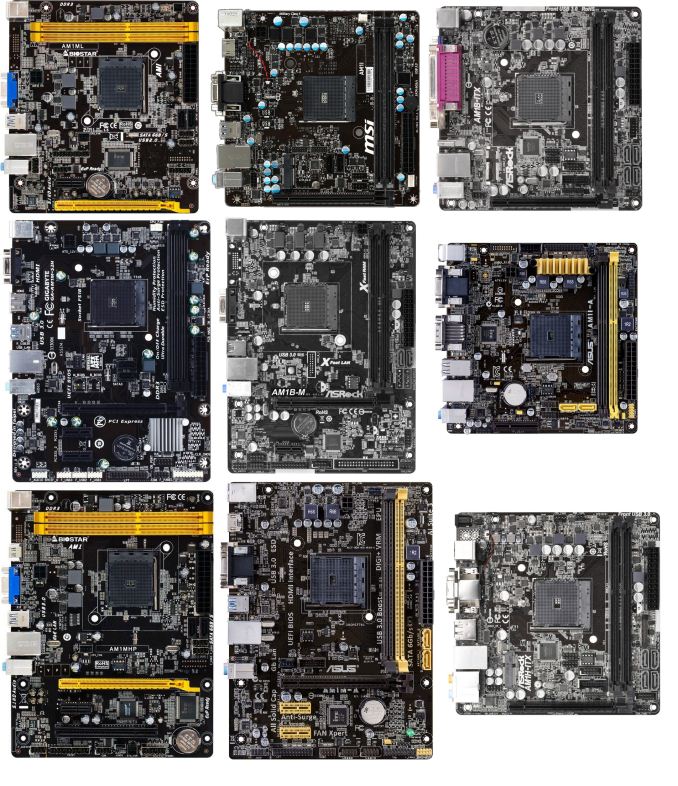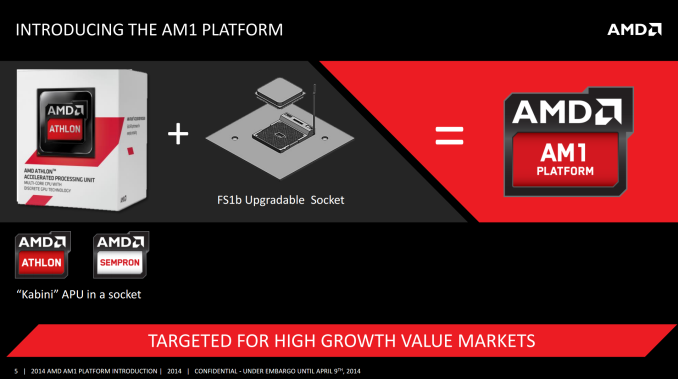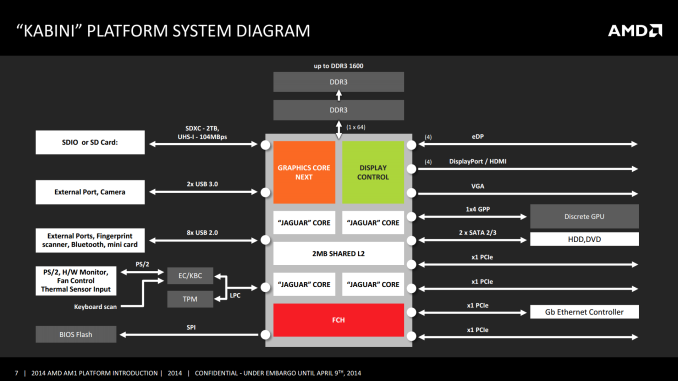The AM1 Kabini Motherboard Preview: Analyzing the Hardware
by Ian Cutress on April 19, 2014 2:00 PM EST
One of AMD’s primary feature points for the AM1 Kabini platform was the introduction of low-cost motherboards. The promotional material provided gave a suggested AM1 combined price of $60. Now after release the cheapest APUs are $31 for a dual core and $35 for a quad core. This should mean motherboards from $29 and up. Today we take a brief preview of nine motherboards currently on sale, which start at $33.
The AM1 Ecosystem
Almost every end-user I converse with prefers naming consistency in technology products. There has to be a clear progression in naming structure showing the development of a platform over time and generations. There have been plenty of examples – AMD’s enthusiast chipset (580/690/790/890/990FX), both AMD and NVIDIA’s GPU lines, Intel’s chipsets (P35, X48, P55, P67, Z77, Z87). The issue arises when the naming scheme is non-contiguous. The naming of AMD’s three main processor and chipset lines are as follows:
The top end features the AM3+ socket, which came from AM3, AM2+ and AM2. The mid-range is the FM2+ socket, deriving from FM2 and FM1. The low-price segment is now being called the ‘AM1 platform’. It makes it sound like it should be a very old version of AM3, because at least colloquially it will just be called AM1. In reality, that word ‘platform’ is the kicker here, because the socket is actually called FS1b:
What makes it called the AM1 platform is the use of a Kabini APU in an FS1b upgradable socket. That does not help that all the motherboards on sale will be given the AM1 designation. This means that if the next iteration of the Athlon processors using ‘Puma’ cores (codename “Beema”) comes along and they call it the ‘AM2 platform’ (insert more confusion with the AM2 socket), it might still be the FS1b socket in the middle of the motherboard.
Naming conventions aside, because Kabini processors are system-on-chips rather than platforms with a discrete south bridge, all the IO is determined on die. AMD is at least keeping the core of the IO the same across all the Kabini APUs:
The key points to note here are:
- Single Channel 64-bit DDR3/DDR3L
- Two USB 3.0
- Eight USB 2.0
- PS/2
- Trusted Platform Module Support
- Up to four eDP/DP/HDMI video outputs
- VGA output
- Four PCIe 2.0 lanes for a discrete GPU/PCIe device
- Two SATA 3 Gbps ports
- One PCIe 2.0 x1 lane allocated to an Ethernet controller
- Three PCIe 2.0 x1 lanes for other controllers (SATA, USB, LAN, WiFi, PCIe 2.0 x1 slots, PCIe to PCI bridges)
As we go through the following motherboards, we will see that some manufacturers use USB 3.0 or SATA 6 Gbps controllers, powered by the PCIe 2.0 x1 lanes, in order to bump up the functionality. There is scope for development in the networking and audio solutions as well.













64 Comments
View All Comments
coolhardware - Monday, April 21, 2014 - link
Sorry for the error on my part, I got the 5150 and 5350 mixed up :-(As per your original post, where did you see that nice 5150 OC? With an ASUS board should the same type OC be possible with the 5350?
Thanks!
yannigr - Tuesday, April 22, 2014 - link
At techpowerup. http://www.techpowerup.com/forums/threads/amd-kabi...But overclocking on this platform is still a big question mark. At Phoronix for example they also tried to overclock ALL the four processors available on the same motherboard and in ALL cases they had stability problems over 105MHz bus speed. So more time is needed to have a definite idea about the overclocking potential on this platform.
As for 5350 I don't know what frequency it can reach. 2100MHz should be easy I guess with just a multiplier change from 20.5 to 21, gut it does make you wonder why AMD didn't gave 5350 the 21 multiplier in the first place.
tech6 - Sunday, April 20, 2014 - link
The problem with the Kabini platform is that it makes too many sacrifices for too little gain. You can buy an Intel G3220 and an MSI H81M mobo for around $100 and while it may consume 10-15W (on paper) more power it will give you about twice the CPU power.As for real world power consumption, I recently build a G3220 system and even when under 100% max CPU and GPU compute using Hash Suite it never exceeded 60W. Under most everyday loads it used about 40W. Given these numbers it is difficult to make a case for the Kabini platform.
savagemike - Sunday, April 20, 2014 - link
I was contemplating similarly. I also wonder with the increased compute power if getting to idle quicker doesn't also attack any power savings.yannigr - Monday, April 21, 2014 - link
You gone from $60 to $100. This isn't "too little gain". Also you forget that the Kabini platform does have better graphics. Much better graphics. And I am not talking (only) about performance, but compatibility also.So, if you need cpu power and you have $100 you can go for Intel. But if you want a better balanced solution in gpu-cpu performance and keep $30-$40 in your pocket, Kabinis are the best option.
mikato - Wednesday, April 23, 2014 - link
I agree.Carleh - Tuesday, April 22, 2014 - link
Does the G3220 support hardware accelerated video decoding?It does support quicksync, but I'm not sure if quicksync can be used for hw accelerated video playback in all applications (flash includeed).
I know the G3220 is powerful enough to do all the decoding in software, but I see no point in using software video decoding in 2014.
Chicken76 - Sunday, April 20, 2014 - link
I remember from the slides that were presented by AMD at launch, that ECC RAM (unbuffered) was supported. Why isn't there a single motherboard that supports it? In it's current form, Kabini is not an option for building a cheap ZFS storage box.Death666Angel - Sunday, April 20, 2014 - link
Why does the motherboard need to support ECC RAM? I'm pretty sure they are physically identical to normal RAM and since the SoC handles all memory (as with most modern CPUs/APUs), the motherboard has no say in it.Chicken76 - Sunday, April 20, 2014 - link
I'm not sure, but if you're not using error correction on a DIMM, do you still need all the traces? They might not have them all in place, to keep costs to a minimum.Besides, you still need BIOS support for ECC.